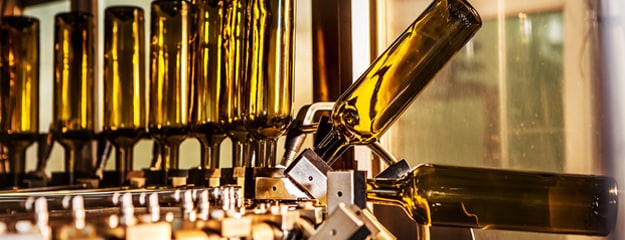When Fluid Transfer Components Do More Harm Than Good

How to combat contamination risks arising from the tubing, hose and fluid transfer systems in beverage packaging design
Beverage packaging processes are, by their nature, susceptible to compromise from a variety of contaminants associated with the fluid transfer components themselves.
The problem, while a serious one, also can be hard to pin down. Bacterial contamination can occur just about anywhere on and even within the fluid transfer components. There’s also a concern about hoses, tubing and fittings that don’t stand up to aggressive washdown and end up corroding or breaking down. Still another worry is using tubing and hoses that leach harmful chemicals into the beverages they transport.
At the bottom of all of these issues, is proper component selection. While the varieties of tubing, hose and fitting products can look very much the same, each will perform very differently depending on its environment.
Packaging equipment OEMs already know they must select components that meet FDA and/or NSF standards if those components come in direct or indirect contact with foods and beverages. While those standards are good ones, there’s even more that OEMs can do to prevent contamination risks from these sources.
By incorporating the latest product features, while taking advantage of support from their trusted suppliers, OEMs will be able to preemptively target these insidious sources of contamination in their packaging machinery builds.
Here, we’ll address the three problem areas and how well-informed product selection can help prevent them from happening.
Give Bacteria the Boot
Bacterial contamination from mildew, algae, fungi, and biofilm is one of the primary concerns that OEMs and end users face in their transfer equipment. The key to tackling this risk begins at the product level.
A common concern is that microorganisms can accumulate on the inside or outside of tubing in filling applications. Stagnant moisture within lines is another problem area, because it can lead to the growth of mold.
Uneven fluid transfer component surfaces and connections will exacerbate the problem. Nooks and crannies between parts or even within tubing can harbor residues and microorganisms that could contaminate products.
Stopping these sorts of contamination depends on both product construction and component design. Tubing, hose, and fittings should be selected specifically because they resist bacterial collection and growth.
OEMs can do this with specially formulated antimicrobial tubing that is designed to protect both inner and outer tube surfaces from degradation, foul odors, microorganisms, and discoloration. Look for tubing that has the antimicrobial additive fully compounded into the tubing, as opposed to tubing with only an antimicrobial liner.
Another option is to use fluoropolymer tubing and/or fittings, as they feature non-stick surfaces to help prevent bacteria from building up within components. OEMs also can specify hoses with a non-stick fluoropolymer liner passing through the inside of the fitting and covering the face of the fitting, further eliminating harborage zones. Such a product will help prevent bacterial entrapment around fittings and promotes unrestricted flow with complete fluoropolymer coverage on all wetted surfaces.
OEMs also should use push-to-connect fittings wherever possible, as these promote smooth surface design by eliminating the need for fasteners. With fewer nooks, crevices and ledges for bacteria to hide, these connectors resist bacterial buildup particularly well.
Smooth surface design applies to transfer hose as well. Hoses used to transport liquids and water should be seamless or manufactured with smooth inner surfaces to resist the buildup of residue that could promote bacterial growth where possible. Hoses with polished, stainless steel mandrels will impart an ultra-smooth tube surface that resists microbes. In addition, specialized hose grades featuring smooth outer surfaces but offering the flexibility of corrugated hose also promote sanitation because they don’t have the corrugation crevices where bacteria could collect.
Make it Wash-Proof
Contamination from product corrosion and stress is another concern that needs to be addressed during product selection. Equipment surfaces must resist daily exposures to harsh cleaning and sanitizing chemicals. If the hose, tubing, and fittings are not chemically compatible with washdown fluids, they could corrode and allow harmful chemicals to contaminate the beverages being transferred.
The use of fluoropolymer tubing and fittings can be ideal in this respect, because it offers the most corrosion- and chemical-resistance of all polymers.
Tubing also can be chosen for its ability to withstand the rigors of liquid transfer pump applications. For example, thermoplastic elastomer tubing features low permeation and abrasion resistance, high resistance to stress cracking, and is chemically compatible with the sanitizers commonly used for fluid transfer applications.
Similarly, thermoplastic push-to-connect fittings meeting NSF requirements offer excellent resistance to harsh chemical environments, as do stainless steel, fluorocarbon and composite fittings.
Prevent Leaching
Leaching of chemicals from within tubing and fittings is another concern in beverage packaging applications. OEMs should work with suppliers to select NSF-certified tubing that is appropriate for each application. Selecting tubing that’s incompatible with certain liquids could end up leaching chemicals or metals into products.
In many beverage packaging designs, it may be appropriate to select specialty thermoplastic tubing that is free of BPA and phthalates to prevent leaching of those materials into products.
When it comes to fittings, NSF- and FDA-approved lead-free fittings that conform to the latest lead-free standard set by the Safe Drinking Water Act can offer additional leaching protection.
Where to Turn for Additional Support
Considering these contamination risks, selecting the proper tubing, hoses, and fittings for each beverage application can be a complicated process. That’s why it’s critical that OEMs work with their supplier to select the range of appropriate products that are ideal for each application from a contamination-prevention point of view.
By working with suppliers and specifying appropriate products carefully, OEMs will be able to combat and control contamination from bacteria, corrosion, or leaching, before they ever become an issue.



